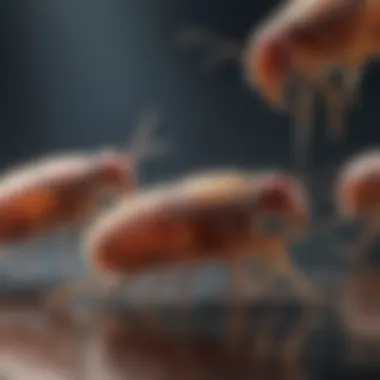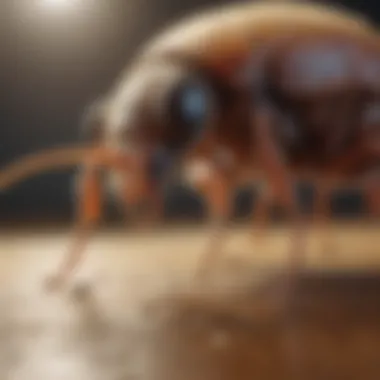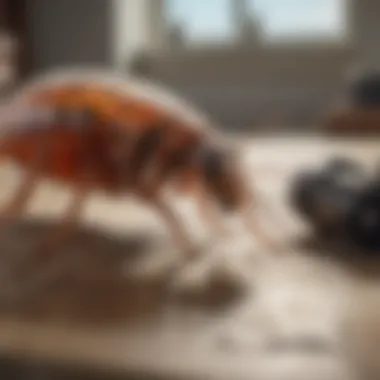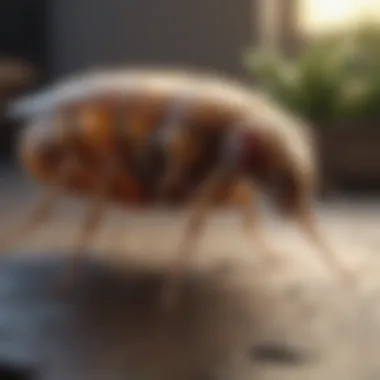Natural Methods to Eliminate Fleas from Your Home


Intro
Flea infestations can turn a comfortable home into a source of stress and discomfort. Understanding the natural methods available to eliminate these pests is crucial for anyone who values their living space. Fleas are not only a nuisance but can also pose health risks to pets and humans. This article provides a detailed guide on effective natural strategies for getting rid of fleas in your home. By enlightening homeowners and housewives about the lifecycle of fleas and the effective natural remedies, we aim to provide practical steps towards a flea-free environment.
Identification of Common Pests
To effectively combat fleas, it is essential to first identify them correctly. This knowledge not only helps in the identification of the larvae and adult fleas but also aids in implementing a successful eradication plan.
Description of Common Pests
Fleas are small, wingless insects, typically measuring 1/16 to 1/8 of an inch in length. They are known for their ability to jump great distances, up to 13 inches vertically. The most common flea species found in homes is the cat flea, Ctenocephalides felis. Their bodies are flat and often brown or reddish-brown in color, making them hard to spot against fur or surfaces.
Signs of Infestation
Detecting a flea problem early can help prevent a larger infestation. Some common signs include:
- Scratching by Pets: If pets are seen scratching more than usual, fleas might be the cause.
- Flea Dirt: This is the fecal matter of fleas and appears as small black specks. It can be found in pet bedding or carpets.
- Bites on Humans: Flea bites usually appear as small red welts on the ankles and lower legs.
- Presence of Flea Eggs: These tiny white eggs can often be found in pet fur or around places where pets sleep.
Early detection is key to effective flea control.
Prevention Techniques
Preventing fleas from entering your home is just as important as eliminating them once they appear. Here are some valuable techniques you can adopt.
Home Maintenance Tips
- Regular Vacuuming: Frequent vacuuming can remove adult fleas, larvae, and eggs from rugs and carpets. Be sure to dispose of the vacuum bag outside to prevent re-infestation.
- Wash Pets’ Bedding: Cleaning pet bedding in hot water regularly can help kill fleas and their eggs.
- Sealing Cracks and Gaps: Inspecting and sealing potential entry points in your home can reduce the likelihood of fleas entering your living spaces.
Environmental Modifications
Making certain adjustments in and around your home can deter fleas:
- Outdoor Cleanliness: Keep your yard clean and free of debris, as fleas can thrive in such areas.
- Grass Height: Maintain grass at a lower height to reduce the number of fleas. Fleas prefer tall grasses as it provides a habitat conducive for their breed.
Eco-Friendly Pest Control Options
If prevention does not work, and an infestation occurs, consider using natural pest control methods. These options are not only effective but also minimize harm to your family and pets.
Natural Pesticides
There are various natural substances that can repel or kill fleas:
- Diatomaceous Earth: This powder can be sprinkled on carpets and pet bedding. It works by dehydrating the fleas.
- Essential Oils: Oils such as lavender, peppermint, and cedarwood have repellent properties. However, they should be used carefully and diluted before applying to pets or living areas.
Organic Pest Control Techniques
- Salt: Sprinkling salt in areas where fleas are likely to gather can dehydrate them and their eggs. Leave it on for at least 24 hours before vacuuming.
- Boric Acid: While not a pesticide, it can be used in specific areas to kill fleas and should be kept away from pets and children.
These methods can significantly aid in controlling fleas while being kind to the environment. Flea control is essential not just for comfort but also for health. Emphasizing natural methods promotes a safe and sustainable approach to pest management.
Understanding Fleas
Understanding fleas is crucial to effectively managing and eliminating them from our living spaces. Fleas are tiny parasites that can infest homes quite easily, disrupting the comfort of our environment. Recognizing the importance of their biology, life cycle, and behaviors can empower homeowners to address infestations more efficiently. Moreover, the knowledge of why fleas invade our homes enables us to implement effective prevention measures.
The Life Cycle of Fleas
Fleas undergo a complex life cycle that consists of four stages: egg, larva, pupa, and adult. This cycle can take as little as a few weeks to several months, depending on environmental conditions such as temperature and humidity. The adult flea lays eggs on the host or nearby surfaces. These eggs typically fall off into carpets, bedding, or other soft furnishings. Once the eggs hatch, the larvae emerge, feeding on organic debris and flea feces.
The next stage is the pupal stage, where larvae spin cocoons. Fleas can remain in this stage for an extended period, sometimes waiting for conditions to be ideal. Finally, adult fleas emerge ready to jump onto new hosts to feed. This adaptability and resilience in their life cycle make controlling flea populations challenging.
Identifying Flea Infestation
Identifying a flea infestation is the first step to manage it. Signs include:


- Flea bites: Small red bumps usually appear in clusters on human skin. Pets may also scratch more than usual.
- Flea dirt: Flea feces resemble tiny black specks. If you wet it, it turns reddish-brown, indicating it contains blood.
- Pet behavior: If a pet is excessively grooming or biting itself, this may signify flea activity.
Awareness of these signs is critical. Early detection often simplifies eradication efforts and reduces discomfort for all household members.
Common Hosts of Fleas
Fleas commonly infest a variety of hosts, primarily pets like dogs and cats. However, they can also latch onto other animals like rodents, rabbits, and even humans. Understanding these host relationships is important. Pet owners should ensure their animals are treated with appropriate flea prevention methods. Additionally, even wild animals or strays can bring fleas into your home environment, exacerbating the problem.
By focusing on these aspects, readers can gain the knowledge necessary to combat fleas effectively, ensuring a healthier living environment.
Reasons for Natural Flea Control
Flea infestations pose challenges that extend beyond mere discomfort. Therefore, it is essential to consider the reasons for embracing natural flea control methods. These approaches not only address the immediate problem of fleas but also bring several long-term benefits. To effectively manage a flea problem, understanding the environmental and health implications of synthetic treatments becomes crucial.
Environmental Concerns
Many common flea control products contain synthetic chemicals. These substances can have significant impacts on the environment. For instance, they may leach into the soil and waterways, causing harm to beneficial organisms. Natural methods, on the other hand, tend to be less harmful. Utilizing options such as diatomaceous earth or essential oils, we can minimize ecological disruption. The benefit of using natural remedies is their reduced toxicity. They are usually biodegradable, ensuring that they do not linger in the ecosystem.
Moreover, adopting natural flea control strategies reflects a shift towards sustainable living. It emphasizes responsibility for our surroundings and promotes the health of our local environment. Engaging in practices that do not threaten biodiversity leads to a healthier ecosystem overall.
Health Implications
The implications of flea control extend into human health as well. Synthetic chemicals used in traditional flea treatments can pose risks to inhabitants, especially children and pets. Some people may have allergic reactions to these substances. Pets, too, can suffer from side effects after exposure to chemical treatments. In contrast, natural methods often provide safer alternatives. For instance, essential oils like lavender and peppermint are not only effective but also less likely to cause health complications.
Additionally, flea bites can lead to significant discomfort and health issues, such as itching and potential transmission of diseases. By implementing natural control methods, homeowners can create a healthier indoor environment. This is essential for anyone who wishes to avoid the adverse effects associated with synthetic pest control solutions.
Important Note: Natural flea control is not just about eliminating pests. It is also about fostering a safe and healthy living space for all inhabitants.
To summarize, the reasons for opting for natural flea control methods include less harm to the environment and improved health for both humans and pets. Addressing these implications enhances the overall well-being of a household, allowing for a more balanced approach to pest management.
Natural Remedies for Flea Control
Natural remedies for flea control are important because they offer effective alternatives to chemical treatments. For homeowners concerned about the safety of their families and pets, these methods provide peace of mind while addressing flea issues. Many of these remedies utilize common household materials, making them accessible and often cost-effective.
Using natural methods also minimizes environmental impacts. Many chemical treatments can be harmful to local wildlife and ecosystems. Natural solutions align more closely with a sustainable approach to pest management. This section will explore several natural remedies, including diatomaceous earth, essential oils, and homemade flea sprays.
Diatomaceous Earth
Diatomaceous earth is a fine powder made from the fossilized remains of tiny aquatic organisms called diatoms. This substance is lethal to fleas when it comes into contact with them, as it disrupts their exoskeletons and leads to dehydration. The effectiveness of diatomaceous earth depends largely on its purity and how finely it is ground.
It is crucial to choose food-grade diatomaceous earth if using it in the home. This is because it is safe for pets and humans, unlike industrial-grade products. When applying it, sprinkle the powder in areas where fleas are likely to hide, such as carpets, pet bedding, and cracks in the floor. Allow it to sit for several hours or overnight for optimal effect. Afterward, vacuum the area thoroughly to remove dead fleas and the powder itself.
Advantages:
- Non-toxic to humans and pets
- Affordable and widely available
- Effective in killing adult fleas and disrupting their lifecycle
Considerations:
- Can be messy during application
- Requires careful vacuuming post-use to ensure effectiveness
Essential Oils for Flea Repulsion
Essential oils are another popular natural method for repelling fleas. These oils offer various benefits, including pleasant scents and antifungal and antibacterial properties. Many essential oils can deter fleas from infesting your home. Below are specific oils that have proven effective in repelling fleas.
Lavender Oil
Lavender oil is well-known for its calming fragrance. In terms of flea control, it serves both as a repellent and as a comfort for pets. The scent of lavender oil is pleasant to humans but is highly unappealing to fleas. This dual-action makes it an ideal choice.
A key characteristic of lavender oil is its versatility. It can be mixed with water to create a spray, used in diffusers, or added to pet bedding. However, like all essential oils, it should be used cautiously, especially around pets, which might have sensitivities.
Advantages:
- Natural and pleasant aroma
- Can promote a calm environment


Considerations:
- Always dilute before applying on pets or skin
- Can cause allergic reactions in rare cases
Peppermint Oil
Peppermint oil is another effective flea repellent due to its strong scent. The menthol in peppermint oil is particularly off-putting to fleas. Using it as an essential oil spray can provide immediate deterrence while also leaving a refreshing smell in your home.
The invigorating scent of peppermint is appealing to many, making it a popular choice. Its unique feature is that it can also act as a natural deodorizer, leaving your home smelling fresh. However, be cautious of applying it directly on pets, as it can be potent.
Advantages:
- Strong, fresh scent
- Acts as a deodorizer
Considerations:
- Avoid direct contact with pets
- May require frequent reapplication
Tea Tree Oil
Tea tree oil is recognized for its antibacterial and antifungal properties. It also works as an effective flea repellent due to its strong aroma. The distinctive feature of tea tree oil is its potential to prevent fungal infections, which can arise in pets affected by fleas.
While tea tree oil is effective, it should be diluted with water or a carrier oil before application. This precaution is necessary to prevent adverse reactions, especially in cats, which are more sensitive to this oil.
Advantages:
- Multifunctional oil with various uses
- Helps maintain skin health in pets
Considerations:
- Needs strong dilution
- Not safe for use on cats
Homemade Flea Sprays
Creating homemade flea sprays is a practical approach to deal with infestations. These concoctions utilize ingredients like vinegar, essential oils, and water. Combining these items creates a solution that can be sprayed directly onto affected areas.
One simple recipe is mixing equal parts of vinegar and water, then adding a few drops of an essential oil like lavender or peppermint. Shake well before using. Applying the spray on carpets, fabrics, and pet bedding can help reduce flea populations.
Homemade sprays offer flexibility in formulations and ensure the absence of harsh chemicals. Plus, they can be tailored to specific preferences based on scent and effectiveness.
Advantages:
- Customizable recipes
- Chemical-free and safe for households
Considerations:
- May require regular reapplication
- Must be used alongside cleaning strategies for best results
Cleaning and Maintenance Strategies
Effective cleaning and maintenance strategies are paramount when it comes to eliminating fleas from your home. These strategies do not merely address the immediate infestation; they also act as a barrier against future occurrences. Understanding the role of cleaning in flea control can significantly enhance the effectiveness of other natural methods discussed in this article. A consistent cleaning routine removes flea eggs and larvae, thereby breaking the life cycle.
Moreover, maintaining a clean environment limits the potential for fleas to thrive. It is essential to consider not only how we clean but also what we clean. Areas where pets frequent are of particular concern because fleas often travel with their hosts. The overlap of cleaning and strategic maintenance is crucial in achieving a flea-free home.
Regular Vacuuming
Vacuuming is often underestimated in its capability to control fleas. Regular vacuuming can eliminate adult fleas, their eggs, and larvae from carpets, rugs, and upholstery. It is important to focus on high-traffic areas, corners, and under furniture. Varying the vacuuming schedule can help disrupt the flea life cycle. For best results, consider using a vacuum with a HEPA filter, as it can capture tiny flea eggs and debris effectively.
After vacuuming, be sure to dispose of the vacuum contents outdoors immediately to prevent reinfestation. If your vacuum allows it, using a pillowcase over the vacuum hose can help capture fleas better. This simple trick makes it easier to transfer the contents outside without spilling. Incorporating vacuuming into your routine is a practical step toward eliminating fleas.
Washing Fabrics and Bedding
Fleas can easily inhabit pet bedding, blankets, and your own bedding. Washing these items regularly is an effective method in your flea eradication arsenal. Using hot water can kill fleas at all stages of their life cycle, ensuring more thorough cleaning. Wash pet bedding, couch covers, and any fabric items your pets interact with at least once a week.


Use a high-quality laundry detergent while washing. Adding a cup of white vinegar can enhance the effectiveness further. Vinegar acts as a natural flea deterrent and can help in eliminating any lingering flea odors that may lead to new infestations. Furthermore, drying your items on a high heat setting can add another layer of protection. This combined approach can significantly reduce fleas in your home.
Decluttering Your Home
A cluttered environment provides numerous hiding spots for fleas. Reducing clutter can minimize these potential hideouts and make cleaning efforts more effective. Focus on commonly cluttered areas such as closets, under beds, and near furniture.
Consider implementing a regular decluttering schedule. Donate or dispose of items you no longer need or use, especially items that are kept in low-traffic areas. Utilize sealed storage containers for items that need to remain in your home; this can prevent fleas from nesting. In addition, an organized living space promotes easier cleaning and maintenance overall. Each of these strategies contributes to a comprehensive approach to flea management.
Preventative Measures
Preventing flea infestations is essential for maintaining a healthy living environment. It is often easier and more effective to avert an issue than to address it after it arises. In this context, preventative measures can protect both your home and pets from the discomfort and health risks that come with fleas. By implementing natural strategies, you can significantly reduce the likelihood of flea problems, saving time, energy, and resources in the long run.
Natural Flea Repellents for Pets
Using natural flea repellents for your pets can create a barrier against pests. Some effective options include essential oils, such as lavender, peppermint, and cedarwood. These oils have properties that repel fleas without harming your pet. Always dilute the oils before applying them to ensure safety. You can mix a few drops with a carrier oil and rub it gently onto your pet’s coat.
Another approach is using apple cider vinegar. This common household item acts as a natural flea repellent. Mixture with water in equal parts can be sprayed lightly on your pet’s fur. This method is often well-received by pets as it also promotes shiny coats.
Regular grooming is also a vital part of flea prevention. Bathing your pet regularly and using flea combs can help remove any fleas before they can infest your home.
Yard Maintenance Practices
The yard is an extension of your home and can easily become a breeding ground for fleas. Proper maintenance is crucial. Keeping the grass trimmed short and clearing away debris can reduce the habitats where fleas thrive. Regularly raking up leaves and cutting back tall grass diminishes shady areas that attract fleas.
You might also consider introducing beneficial nematodes to your yard. These microscopic worms can be applied to your garden and naturally prey on flea larvae, helping to control population levels. Furthermore, laying down diatomaceous earth in areas where your pets frequent can deter fleas and other pests safely.
Establishing a boundary of gravel or wood chips around your property can also help. It creates a physical barrier to flea entry.
By integrating these strategies, you strengthen your home's defenses against fleas. Regular monitoring and maintenance make a substantial difference in your ability to keep your environment flea-free.
"An ounce of prevention is worth a pound of cure."
When Natural Methods Are Insufficient
As effective as natural remedies can be, there are times when they may not suffice. Recognizing when to take further measures is crucial in maintaining a flea-free environment. Natural methods often work best in conjunction with ongoing preventive measures. However, severe infestations may require additional intervention to eliminate fleas entirely. Understanding the criteria that define a severe infestation enhances your ability to act promptly. Consulting professionals can also provide insights and solutions that may not be apparent through DIY methods.
Recognizing Severe Infestations
Severe flea infestations are more than just an annoyance; they can lead to health risks for both pets and humans. Here are some indicators to watch for:
- High Visibility of Fleas: If you see numerous fleas jumping around or nesting in your carpets, this could suggest a serious problem.
- Flea Bites: Frequent bites on you or your pets are a strong sign that fleas have established a significant presence.
- Flea Larvae: The discovery of flea eggs or larvae in carpets, bedding, or pet areas warrants immediate action.
- Pet Behavior Changes: Excessive scratching, biting, or grooming by pets can indicate a higher infestation level.
If you observe these signs, it’s essential not to delay interruption of the lifecycle of fleas. The longer you wait, the more established they become, making eradication much harder.
Consulting Pest Control Professionals
In cases where natural methods have failed, consulting pest control professionals becomes necessary. Trained pest control experts possess techniques and treatments tailored for serious infestations. Here's what you can expect when consulting professionals:
- Assessment: They will assess your home to understand the extent of the infestation and identify hot spots.
- Effective Solutions: Professionals use both natural and chemical-based solutions that your home may need. Not all products are safe for homes with children or pets, so they will be mindful of what to use.
- Follow-up Treatments: Re-infestations can occur if not adequately addressed, so follow-up visits may be necessary.
- Prevention Tips: Apart from extermination, they can provide valuable advice on future prevention strategies.
Consulting with pest control can be seen as a last resort, but when it is necessary, it often leads to a cleaner, healthier space much quicker. Proper management of a severe flea infestation will protect your home and loved ones, ensuring that natural approaches can again be effectively utilized once the immediate threat has been resolved.
Remember: A persistent flea problem can lead to increased stress not only for your pets but also for the entire household. Don’t hesitate to seek help when natural methods fall short.
End
The need for effective pest control, particularly when it comes to fleas, often finds many home owners seeking natural methods. This article emphasizes the vital role that such methods play in maintainig a flea-free home, encompassing environmental awareness, toxic-free solutions, and long-term prevention strategies.
Long-term Maintenance of a Flea-Free Home
Promoting a flea-free environment doesn't end with immediate treatments. Maintaining cleanliness is crucial. Regular vacuuming should be part of your routine. Vacuuming not only removes fleas, but also their eggs and larvae from carpets and upholstery.
In addition, washing fabrics frequently, including pet bedding and your own linens, plays an important part in disrupting the flea lifecycle. High temperatures can kill eggs and prevent reinfestation. Also, consider decluttering your home. Fleas enjoy hiding in small, undisturbed spaces. By keeping your living area organized, you reduce potential hiding spots.
Remember: Consistent maintenance is key in keeping your home flea-free.
Yard maintenance also contributes. Keeping grass trimmed and plants cleared of debris will deter fleas that can migrate indoors. Regularly checking pets for fleas and using natural repellents can further enhance your home's defenses.
In summary, long-term maintenance of a flea-free home involves a combination of regular cleaning, washing, and preventive measures. This approach not only keeps fleas at bay but also ensures a healthier living space for everyone.







